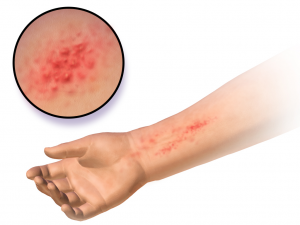
If you’ve noticed patches of red bumps or welts appearing on your skin, you might be suffering from hives. These itchy, occasionally painful areas can range in size from a pea to a dinner plate and typically occur in reaction to allergen exposure. About 20 percent of people experience hives at some point, according to the American College of Allergy, Asthma, and Immunology. The good news is that hives treatment is effective and relatively simple.
What Causes Hives?
Hives appear when histamine release happens in the body. This can occur as a reaction to allergens, certain foods, insect stings, medications, environmental conditions, and even exposure to sunlight. In response to the histamine release, plasma is leaked from the small blood vessels in the skin, leading to the hives rash.
How Are Hives Treated?
The first line of defense when it comes to hives is a prescription for an antihistamine to relieve itching. Your doctor will choose a non-drowsy formula that can be safely taken during the day. While this medication is effective for mild to moderate hives treatment, more severe cases may require prescription creams or even injections for chronic hives cases. In these situations, skin testing may be used to determine the cause.
In addition to these hives treatments, home care can help soothe the discomfort associated with hives. Apply cold compresses to the affected area, make sure to sleep in a cool room, and wear lightweight, loose-fitting clothing to avoid further irritating the skin. Protect yourself from the sun when you go outside.
If you have hives and notice other symptoms like dizziness, difficulty breathing, tightness in the chest, and facial swelling, seek immediate medical attention as these can be signs of a severe allergic reaction. For most people, though, hives are minor and tend to occur less frequently with age.
